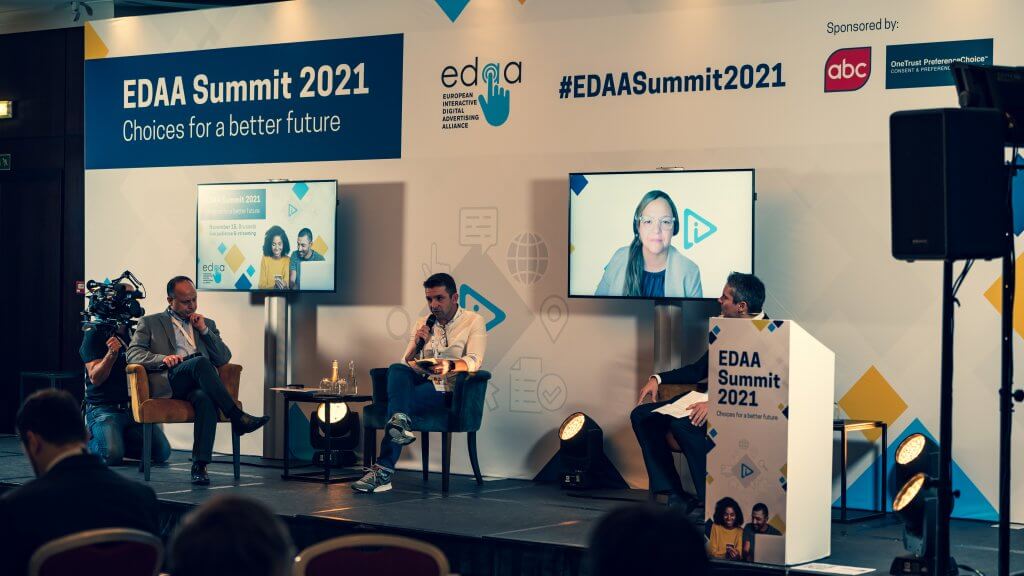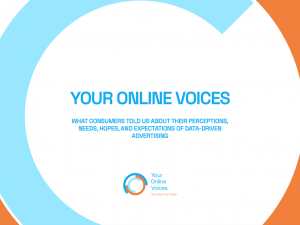
The 2021 EDAA Summit: Choices for a better future was an event that brought together industry, regulators, and users in a hybrid format to discuss the future of self-regulation in the online advertising ecosystem. In a series of blogs, Federica Detomas, our Communications and Projects Assistant, asks the speakers a series of questions posed by the audience that were left unanswered during an afternoon of packed content.
Part of the distinguished roster of speakers at the EDAA Summit, were representatives from the global DAA network. Graciously joining us from Canada we had Julie Ford, Executive Director, DAAC; from the US, Lou Mastria, Executive Director, DAA kindly accepted the invitation, and our very own Ionel Naftanaila, Programme Development Director, EDAA completed the trio. Masterfully moderating the discussion on privacy developments worldwide and their impact on self-regulatory standards and codes was Lucas Boudet, Director General, European Advertising Standards Alliance (EASA). We wanted to follow-up the discussion on stage with a few additional questions and thoughts about the session and self-regulation as a whole.
Federica: For those that couldn’t join us but would be interested to know more, could you sum up your key messages on the day in just one or two sentences?
Julie: Self-regulation can be flexible where laws can’t be – but our work needs to always be of value to the industry and the consumer.
Ionel: The key principles of transparency, choice and control, and user education are more relevant now than ever before. Self-regulation is all about doing the right thing by the consumer while ensuring a sustainable ecosystem. All of us working in this industry or connected fields are surely aware that there’s unprecedented regulatory pressure for the advertising industry and that Europe is at the forefront of it, and that we must work together as one to ensure this sustainability we are talking about. As the saying goes – “the best time to plant a tree was 20 years ago. The second best time is now”.
Lou: In the United States, we are promoting a national legislative framework through the Privacy For America initiative which would clearly define prohibited data practices that make personal data vulnerable to breach or misuse, while preserving the benefits that come from responsible use of data. That said, our DAA Principles self-regulatory framework – independently enforced for more than a decade now – stand as a testament and an example of how a Principles-based regimen can be applied flexibly and nimbly to facilitate real consumer transparency and control without harming innovation, and while improving consumer-brand engagement, competition and economic growth.
For example, we have adapted all our Consumer Choice tools to a cookie-and-beyond environment, creating ways that consumers can control new identifiers whether they be tokens – such as email, among other identifiers – to enable an advertising data collection choice. We are also working on new innovations that complement Consent Management Platforms with additional choices and preferences. These innovations are being built with the ability of our global partners (Europe, Canada, Latin America, thus far) to adapt and adopt these for their use. We are very excited for this and have received positive feedback from companies and trade associations for the ability to address additional areas of transparency and control in the market while also providing tools that address emerging policy issues.
Federica: How is self-regulation positioned today in the respective markets? How does it remain relevant within an ever-changing regulatory environment, and with potentially tougher regulation on the horizon?
Julie: The DAAC approaches self-regulation as layered atop of existing privacy laws here in Canada. It thrives because it provides sector-specific guidance. Self-regulation can remain relevant by staying a step ahead, being nimble, advocating through submissions and government relations, and keeping the communications open at the board and participant level to ensure we are always treading on the right path.
Ionel: Self-regulation in digital advertising continues to be positioned above and beyond legislative requirements. This is of course a challenge, but in retrospective, after the GDPR implementation, this challenge seems to be a little less than we were anticipating. To explain – EDAA’s Self-Regulatory Programme was, and is, about three key pillars: transparency, choice and control, and consumer education. I think everyone agrees that these three key pillars remain as relevant now as they ever were, if not more so. Legislation is of course the baseline, and that baseline seems to be always moving up; I believe though that the legislative bar is not moving up by itself – there’s a driving force behind it. And that force is consumer and societal expectations, both fast evolving. And self-regulation is, and always was always about this – keeping up with these evolutions, consumers-first, bridging the gaps where possible and generally working in a proactive way with the industry to mitigate new issues raised by advances in technology, business, and attitudes. We at EDAA do consumer research to understand these attitudes, understand how industry can address the issues, and we are working on the three dimensions – transparency, choice and control, and education – to mitigate them. In terms of new regulations – this is by design where self-regulation can always help, by addressing the underlying issue at industry level.
Lou: The state-level activity in the US underscores the needs for one national standard for the United States. A single national privacy law has overwhelming public support from all Americans – Democrats, Republicans and Independents. Yet, with other priorities before Congress, we’re not certain when legislation might move. Yet you asked about self-regulation – and we’re not stopping. In the year ahead, we likely will expand our Principles interpretation to providing transparency and control on Connected Devices, as well as additional items of pressing concern for the market. We also are continuing our commitment to Political Ads transparency as we approach the U.S. midterms in November 2022. This illustrates relevancy and context of our program – always advancing.
Federica: Where do the challenges and opportunities lie for self-regulation? What gaps need to be filled, keeping in mind consumers and industry players alike?
Julie: The fragmentation of identity and devices are key challenges for programs like ours, where we need to provide centralized resources and tools for the industry and for consumers. But we have an excellent foundation: The standardized AdChoices icon acts as a transparency vehicle both at the site and ad level, we have public choice mechanisms, and independent accountability partners are helping us to keep companies in compliance with the principles. We need to build on these strengths by committing to tool improvements to preserve network-wide choices in a post-third-party cookie world, and ensuring our guidance documents are consistently up-to-date.
Ionel: There’s important work going on for each of our key dimensions – transparency, choice and control, and education. We’ve already announced an initiative to improve transparency in digital advertising by providing, via the AdChoices icon, enhanced real-time information about the ad being served. When we informed of this development publicly, we were discussing about showing why a specific ad was shown to a device, and the chain of parties who were involved in the delivery of the ad, in addition to the information already provided by the AdChoices Icon. We are continuing the work on this project – and of course bearing in mind additional transparency needs and objectives now that there’s a new legislative development that speaks very imperatively about those very issues and broadens the notion of meaningful transparency – the Digital Services Act. The EDAA is particularly well positioned to rise to that challenge as we are able to build on thinking that has already been well underway even before the draft DSA obligations have been tabled and are subject to ongoing negotiations. Moreover, on education, we’ve worked on a set of materials addressing the younger generations – kids – in partnership with a well-respected organisation focused on media literacy in the UK – MediaSmart. With them we’ve prepared teaching materials for schools, where information about digital advertising, how it works, what is the value exchange, and what controls people have in place, is delivered to students. We are now working with partners in a number of European markets to extend the very encouraging UK pilot. When it comes to control, Europe of course has lots of challenges to address, and the situation there is more complex. We are, however, engaged in critical conversations with the wider DAA family internationally, monitoring developments in the US and in Canada, and exploring ways in which those projects can be useful in Europe as well.
Lou: DAA-commissioned research in 2020 and 2021 both underscore the opportunities. First, U.S. consumers value immensely what advertising finances online and in mobile environments, a value they assign at US$1,400. Additionally, they overwhelmingly correctly recognize the “AdChoices” icon as a portal to privacy information. These two conclusions should lead all of us in the advertising ecosystem to build on the power of AdChoices – and the value we extend to consumers in the marketplace – to leverage transparency and control, among all our Principles, for meaningful, real-time, always-on consumer education.
Federica: On the topic of transparency in commercial advertising – we’ve heard a lot about that today. What are you doing to help provide enhanced transparency to users?
Ionel: The EDAA was set-up ten years ago specifically to address (along with user education, choice and control) the issue of enhanced transparency in digital advertising. The fundamental Programme Principles have transparency at their core. It is very encouraging at the same time to see today that most of what EDAA stands for, in terms of transparency, is being validated by legislators in some of the proposals currently on the table in Brussels. It’s also reassuring to anticipate through this lens how the Programme can continue to provide value, on the long run, for participating companies, consumers, and the ecosystem as a whole.
Federica: Thank you all and looking forward to seeing you again, either on stage or in the audience, on November 15 2022 for the next edition of EDAA Summit.
A word from the moderator, Lucas Boudet:
I would like to warmly thank all our panellists for their great insights into self-regulatory initiatives across the world. I would also like to thank because through the initiatives they showcased they captured and exemplified key characteristics and of self-regulatory programmes. Flexibility, nimbleness, accountability, independent consumer-facing enforcement are four core characteristics and benefits of effective self-regulation. With regard to flexibility and nimbleness, in today’s fast-paced environment, it is without a doubt that self-regulation in each jurisdiction needs to adapt.
- It must adapt to increasing regulatory pressures; I am thinking, for instance, about the DSA which is being introduced in Europe.
- II must adapt to changing expectations of consumers; (who are increasingly digitally savvy, questioning traditional models of data collection).
- It must embrace innovative technologies being tested and adopted in response to privacy challenges.
Initiatives by the Digital Advertising Alliance (EDAA), the Digital Advertising Alliance of Canada (DAAC) and the Digital Advertising Alliance (DAA) are powerful examples of how self-regulatory programmes are doing just that.
For instance, in some geographies, consumer education and consumer research make up a two-way street allowing industry and consumer to better understand one another. Easily identifiable and actionable solutions such as the ‘AdChoices Icon’ provide consumers with enhanced real-time information about the ad being served. Complementing legal requirements, not only do these features empower the consumer by allowing real-time interactions but they are dynamic and their functionalities are being adapted to respond to the changing technological an regulatory environment. Furthermore, they are adapted in each market to be as meaningful as possible. Regarding accountability and independent consumer-facing enforcement, this localisation extends through to compliance and enforcement of the respective programmes. In Europe, for instance, the well-recognised network of national self-regulatory organisations (“SROs”), members of the European Advertising Standards Alliance, successfully enforce the self-regulatory programme. At local level, they efficiently handle consumer queries and complaints in the consumer’s own language.
Programmes such as those administered by the DAA, EDAA and DAAC have been providing consumers with transparency, choice, control for over a decade; looking forward, thanks to their self-regulatory nature, they will, for sure, adapt to the fast-evolving societal and regulatory landscape and remain relevant for everyone: consumers, but also participating companies and the entire ecosystem as a whole.
Watch the Summit 2021 Aftermovie and the interviews, and browse through photos from the event here.






